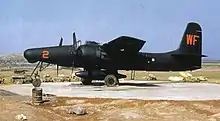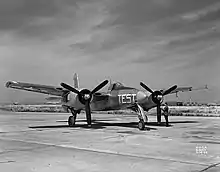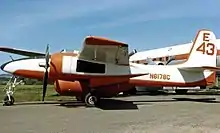Grumman F7F Tigercat
The Grumman F7F Tigercat is a heavy fighter aircraft that served with the United States Navy (USN) and United States Marine Corps (USMC) from late in World War II until 1954. It was the first twin-engine fighter to be deployed by the USN. While the Tigercat was delivered too late to see combat in World War II, it saw action as a night fighter and attack aircraft during the Korean War.
| F7F Tigercat | |
|---|---|
 | |
| An F7F-3P preserved in United States Marine Corps markings in flight | |
| Role | Heavy fighter |
| National origin | United States |
| Manufacturer | Grumman |
| First flight | 2 November 1943 |
| Introduction | 1944 |
| Retired | 1954 |
| Primary users | United States Navy United States Marine Corps |
| Produced | 1943–1946 |
| Number built | 364 |
| Developed into | Grumman XTSF |
Designed initially for service on Midway-class aircraft carriers, early production F7Fs were land-based variants. The type was too large to operate from older and smaller carriers, and only a late variant (F7F-4N) was certified for carrier service.
Design & development
Based on the earlier Grumman XP-50 that was eventually canceled, the company developed the XP-65 (Model 51) further for a future "convoy fighter" concept. In 1943, work on the XP-65 was terminated in favor of the design that would eventually become the F7F.[1] The contract for the prototype XF7F-1 was signed on 30 June 1941. Grumman's aim was to produce a fighter that outperformed and outgunned all existing fighter aircraft, and that had an auxiliary ground attack capability.[2]

Performance of the prototype and initial production aircraft met expectations; the F7F was one of the fastest piston-engine fighters, with a top speed significantly greater than single-engine USN aircraft – 71 mph faster than a Grumman F6F Hellcat at sea level.[3] Captain Fred Trapnell, one of the premier USN test pilots of the era, stated: "It's the best damn fighter I've ever flown."[4] The F7F was to be heavily-armed: four 20 mm cannon and four 50 caliber (0.50 in; 12.7 mm) machine guns, as well as underwing and under-fuselage hardpoints for bombs and torpedoes. This speed and firepower was bought at the cost of heavy weight and a high landing speed, but what caused the aircraft to fail carrier suitability trials was poor directional stability with only one engine operational, as well as problems with the tailhook design.[5] The initial production series was, therefore, used only from land bases by the USMC, as night fighters with APS-6 radar.[6]
While the F7F was initially also known as the Grumman Tomcat, this name was abandoned, because it was considered at the time to have excessively sexual overtones;[7] (from the 1970s, the name Tomcat became commonly associated with, and officially used by the Navy for, another Grumman design, the F-14 twin-jet carrier-based interceptor). The first production variant was the single-seat F7F-1N aircraft; after the 34th production aircraft, a second seat for a radar operator was added and these aircraft were designated F7F-2N.
A second production version, the F7F-3, was modified to correct the issues that caused the aircraft to fail carrier acceptance, and this version was again trialled on the USS Shangri-La. A wing failure on a heavy landing caused the failure of this carrier qualification as well. F7F-3 aircraft were produced in day fighter, night fighter, and photo-reconnaissance versions.[8]
The final production version, the F7F-4N, was extensively rebuilt for additional strength and stability, and did pass carrier qualification, but only 12 were built.[8]
Operational history
Marine Corps night fighter squadron VMF(N)-513 flying F7F-3N Tigercats saw action in the early stages of the Korean War, flying night interdiction and fighter missions and shooting down two Polikarpov Po-2 biplanes.[9] This was the only combat use of the aircraft.
Most F7F-2Ns were modified to control drones for combat training, and these gained bubble canopies over the rear cockpit for the drone controller. An F7F-2D used for pilot transitioning also had a rear sliding, bubble canopy.[10]
In 1945, two Tigercats, serial numbers TT346 and TT349, were evaluated, but rejected by the British Royal Navy, who preferred a naval version of the de Havilland Hornet.[11]
Variants


-531.jpeg.webp)
- XP-65
- Proposed United States Army Air Forces pursuit fighter.
- XF7F-1
- Prototype aircraft, two built.
- F7F-1 Tigercat
- Twin-engine fighter-bomber aircraft, powered by two Pratt & Whitney R-2800-22W radial piston engines. First production version, 34 built.
- F7F-1N Tigercat
- Single-seat night fighter aircraft, fitted with an APS-6 radar.
- XF7F-2N
- Night-fighter prototype, one built.
- F7F-2N Tigercat
- Two-seat night fighter, 65 built.
- F7F-2D
- Small numbers of F7F-2Ns converted into drone control aircraft. The aircraft were fitted with a Grumman F8F Bearcat windshield behind the cockpit.
- F7F-3 Tigercat
- Single-seat fighter-bomber aircraft, powered by two Pratt & Whitney R-2800-34W radial piston engines and featuring an enlarged tailfin for improved stability at high altitudes, 189 built.
- F7F-3N Tigercat
- Two-seat night fighter aircraft, 60 built.
- F7F-3E Tigercat
- Small numbers of F7F-3s were converted into electronic warfare aircraft.
- F7F-3P Tigercat
- Small numbers of F7F-3s were converted into photo-reconnaissance aircraft.
- F7F-4N Tigercat
- Two-seat night-fighter aircraft, fitted with a tailhook and other naval equipment, 13 built.
Surviving aircraft




Beginning in 1949, F7Fs were flown to the then-U.S. Navy storage facility at Naval Air Station Litchfield Park, Arizona.[12] Although the vast majority of the airframes were eventually scrapped, a number of examples were purchased as surplus. The surviving Tigercats were primarily used as water bombers to fight wildfires in the 1960s and 1970s and Sis-Q Flying Services of Santa Rosa, California, operated an F7F-3N tanker in this role until retirement in the late 1980s.
- Airworthy
- F7F-3
- 80374: privately owned in Wilmington, Delaware.[13]
- 80375: privately owned in Bellevue, Washington.[14]
- 80390: based at Lewis Air Legends in San Antonio, Texas.[15][16]
- 80411: based at Palm Springs Air Museum in Palm Springs, California.[17][18]
- 80425: privately owned in Seattle, Washington.[19]
- 80483: privately owned in Houston, Texas.[20]
- 80503: based at Lewis Air Legends in San Antonio, Texas.[21][22]
- 80532: privately owned in Bentonville, Arkansas.[23]
- On display
- F7F-3
- 80373: National Naval Aviation Museum in Naval Air Station Pensacola, Florida.[24]
- 80382: Planes of Fame Air Museum in Chino, California.[25]
- 80410: Pima Air & Space Museum, adjacent to Davis–Monthan Air Force Base, in Tucson, Arizona.[26]
- Under restoration or in storage
- F7F-3
- 80404: in storage at the Fantasy of Flight in Polk City, Florida.[27]
Specifications (F7F-4N Tigercat)

Data from Jane's Fighting Aircraft of World War II[28]
General characteristics
- Crew: 2
- Length: 45 ft 4 in (13.82 m)
- Wingspan: 51 ft 6 in (15.70 m)
- Height: 16 ft 7 in (5.05 m)
- Wing area: 455 sq ft (42.3 m2)
- Airfoil: root: NACA 23015; tip: NACA 23012[29]
- Empty weight: 16,270 lb (7,380 kg)
- Max takeoff weight: 25,720 lb (11,666 kg)
- Powerplant: 2 × Pratt & Whitney R-2800-34W Double Wasp 18-cylinder air-cooled radial piston engines, 2,100 hp (1,600 kW) each
- Propellers: 3-bladed constant-speed fully-feathering propellers
Performance
- Maximum speed: 460 mph (740 km/h, 400 kn)
- Range: 1,200 mi (1,900 km, 1,000 nmi)
- Service ceiling: 40,400 ft (12,300 m)
- Rate of climb: 4,530 ft/min (23.0 m/s)
Armament
- Guns:
- 4 × 20 mm (0.79 in) AN/M3 cannon (200 rpg, wing roots)
- 4 × 0.50 in (12.7 mm) M2 Browning machine gun (400 rpg, in nose) (normal fighter versions only; replaced by radar unit in the -3N nightfighter)
- Bombs:
Avionics
- AN/APS-19 radar
See also
Related development
Aircraft of comparable role, configuration, and era
- de Havilland Hornet
- FMA I.Ae. 30 Ñancú
- Focke-Wulf Ta 154
- Kawasaki Ki-102
- Mitsubishi Ki-83
- Northrop P-61 Black Widow
- Rikugun Ki-93
Related lists
References
- Notes
- Dorr and Donald 1990, p. 119.
- Thruelsen 1976, p. 204.
- Meyer 2002, p. 51.
- Meyer 2002, p. 54.
- Meyer 2002, p. 55.
- Thruelsen 1976, p. 205.
- Meyer 2002, p. 50
- Taylor 1969, p. 504.
- Grossnick and Armstrong 1997
- Gault 1973, p. 25.
- Zuk 2004, p. 129.
- Legg 1991, p. 26.
- "FAA Registry: N7629C". FAA.gov. Retrieved: 30 October 2020.
- "FAA Registry: N379AK". FAA.gov. Retrieved: 30 October 2020.
- "FAA Registry: N700F". FAA.gov. Retrieved: 30 October 2020.
- "Grumman F7F Tigercat/Bu. 80390". Lewis Air Legends. Retrieved: 13 January 2020.
- "FAA Registry: N207F." FAA.gov. Retrieved: 30 October 2020.
- "Grumman F7F Tigercat/Bu. 80411". Palm Springs Air Museum. Retrieved: 23 February 2014.
- "FAA Registry: N909TC". FAA.gov. Retrieved: 30 October 2020.
- "FAA Registry: N6178C". FAA.gov. Retrieved: 30 October 2020.
- "FAA Registry: N747MX". FAA.gov. Retrieved: 30 October 2020.
- "Grumman F7F Tigercat/Bu. 80503". Lewis Air Legends. Retrieved: 13 January 2020.
- "FAA Registry: N7195C". FAA.gov. Retrieved: 30 October 2020.
- "Grumman F7F Tigercat/Bu. 80373". National Naval Aviation Museum. Retrieved: 23 March 2020.
- "Grumman F7F Tigercat/Bu. 80382". Planes of Fame Museum. Retrieved: 23 March 2020.
- "Grumman F7F Tigercat/Bu. 80410". Pima Air & Space Museum. Retrieved: 23 March 2020.
- "FAA Registry: N7626C". FAA.gov. Retrieved: 30 October 2020.
- Bridgman 1946, p. 233.
- Lednicer, David. "The Incomplete Guide to Airfoil Usage". m-selig.ae.illinois.edu. Retrieved 16 April 2019.
- Bibliography
- Bridgman, Leonard (ed.). "The Grumman Tigercat." Jane's Fighting Aircraft of World War II. London: Studio, 1946. ISBN 1-85170-493-0.
- Carlson, Ted. "Semper Fi Tigercat". Flight Journal, Volume 13, Issue 2, April 2008.
- Carr, Orrin I. "Fire 'Cat!" Air Classics, Vol. 12, No. 9, Sept. 1976. Canoga Park, CA: Challenge Publications, pp. 38–47.
- Dorr, Robert F. and David Donald. Fighters of the United States Air Force. London: Temple, 1990. ISBN 0-600-55094-X.
- Gault, Owen. "Grumman's Tiger Twins: The Skyrocket & Tigercat". Air Classics, Vol. 9, No. 8, Aug. 1973. Canoga Park, CA: Challenge Publications, pp. 22–27.
- Green, William. "Grumman F7F-1 – F7F-3 Tigercat". War Planes of the Second World War, Volume Four: Fighters London: Macdonald & Co.(Publishers) Ltd., 1961, pp. 106–108. ISBN 0-356-01448-7.
- Green, William and Gordon Swanborough. "Grumman F7F Tigercat". WW2 Fact Files: US Navy and Marine Corps Fighters. London: Macdonald and Jane's Publishers Ltd., 1976, pp. 57–61. ISBN 0-356-08222-9.
- Grossnick, Roy A. and William J. Armstrong. United States Naval Aviation: 1910–1995. Annapolis, MA: Naval Historical Center, 1997. ISBN 0-16-049124-X.
- Legg, David. "Tigercat on camera". Aircraft Illustrated, Volume 24, no. 1, January 1991.
- Meyer, Corwin ("Corky") H. "F7F Tigercat: The Untold Story". Flight Journal, August 2002. Ridgefield, CT: AirAge Publications. pp. 48–56, 58.
- Morgan, Eric B. "Grumman F7F Tigercat F.7/30". Twentyfirst Profile, Volume 1, No. 11. New Milton, Hants, UK: 21st Profile Ltd. ISSN 0961-8120.
- Morgan, Eric B. "The Grumman Twins". Twentyfirst Profile, Volume 2, No. 15. New Milton, Hants, UK: 21st Profile Ltd. ISSN 0961-8120.
- O'Leary, Michael. "Tigercat Restoration". Air Classics, Vol. 38, No. 11, Nov. 2002. Canoga Park, CA: Challenge Publications.
- O'Leary, Michael. United States Naval Fighters of World War II in Action. Poole, Dorset, UK: Blandford Press, 1980. ISBN 0-7137-0956-1.
- Taylor, John W.R. "Grumman F7F Tigercat". Combat Aircraft of the World from 1909 to the Present. New York: G.P. Putnam's Sons, 1969. ISBN 0-425-03633-2.
- Thruelsen, Richard. The Grumman Story. New York: Praeger Publishers, Inc., 1976. ISBN 0-275-54260-2.
- Zuk, Bill. Janusz Zurakowski: Legends in the Sky. St. Catharine's, Ontario: Vanwell, 2004. ISBN 1-55125-083-7.
External links
| Wikimedia Commons has media related to Grumman F7F Tigercat. |